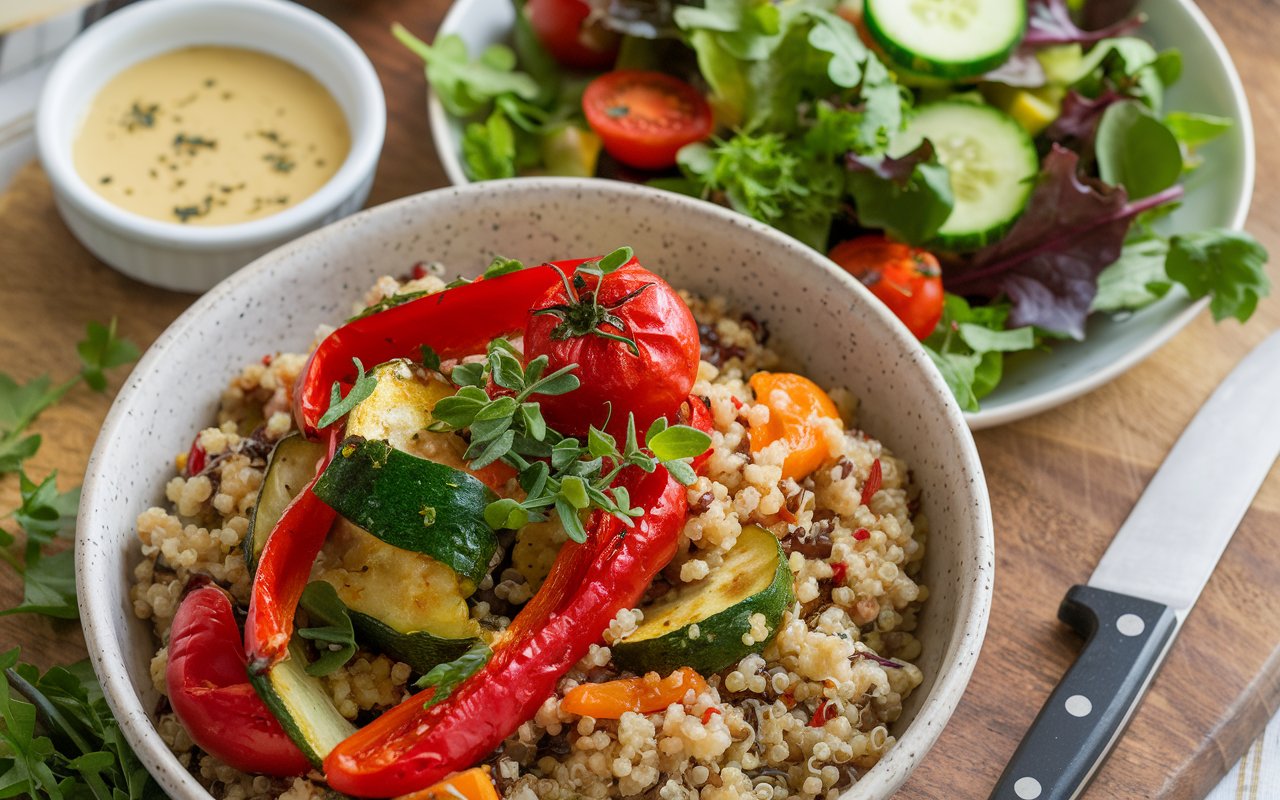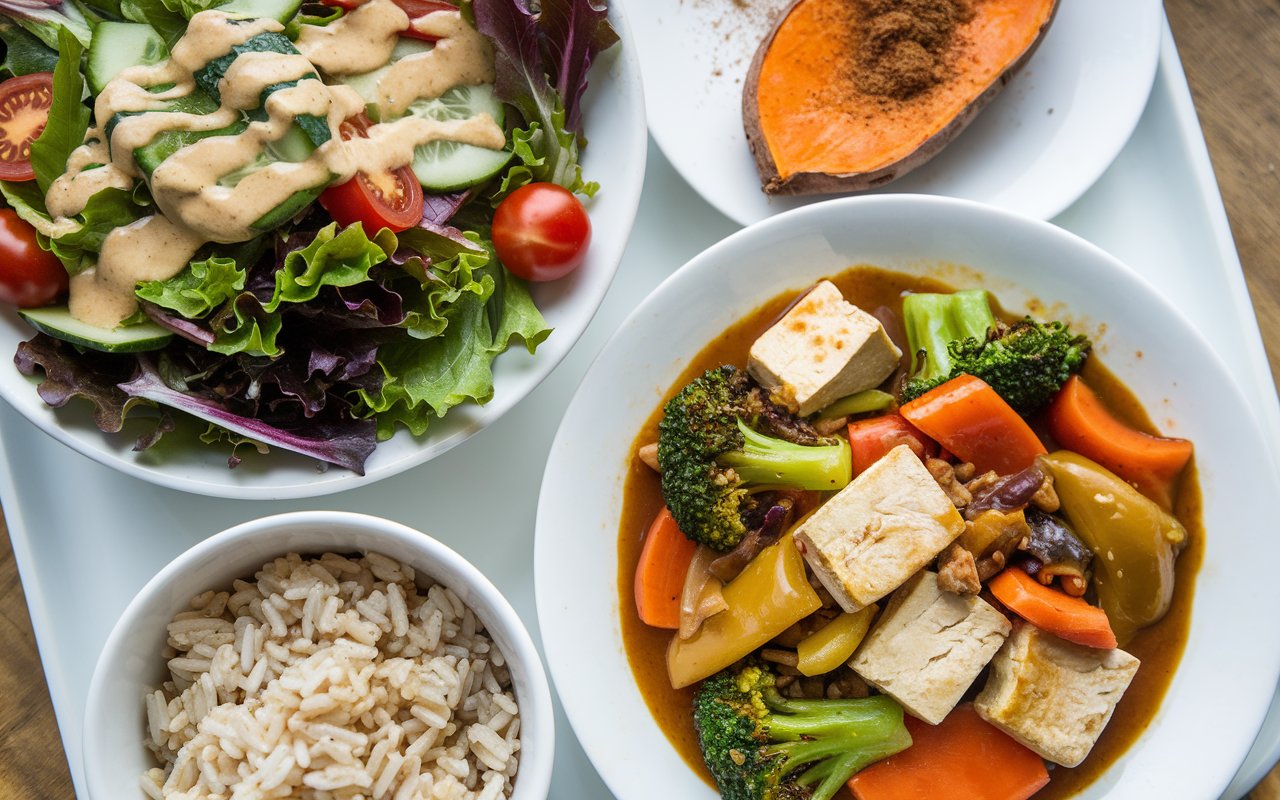Veganism has rapidly grown around the world. What used to be a niche lifestyle is now a popular dietary choice embraced by millions. A typical vegan meal does not include any animal products. Instead, it focuses entirely on plant-based foods like vegetables, grains, legumes, nuts, and seeds. People choose veganism for many reasons. These include health benefits, protecting the environment, and caring for animal welfare.
For many, the idea of starting a vegan diet can seem overwhelming. Meal planning is often a big challenge. Therefore, this article aims to explain what a typical vegan meal looks like. It breaks down the components and offers practical tips. These tips will help you create balanced, nutritious, and satisfying dishes.
What Makes Up a Typical Vegan Meal?
A typical vegan meal is far from boring or repetitive. Instead, it’s a mix of different flavors, textures, and colors. A vegan meal includes a variety of ingredients. These meals combine to create dishes that are both nourishing and tasty. The key parts of a vegan meal are:
- Whole grains: These are important for fiber and complex carbohydrates. Common options include quinoa, brown rice, oats, barley, and farro.
- Legumes: These are key sources of protein and iron. Examples include beans, lentils, chickpeas, and peas.
- Vegetables and fruits: These provide vitamins, minerals, and antioxidants. They also play a key role in keeping us healthy.
- Nuts and seeds: These offer healthy fats and protein. Additionally, they add important nutrients like magnesium and vitamin E, which improve the texture of meals.
By including these elements, you ensure that vegan meals are not only satisfying but also meet your nutritional needs. If you’re new to veganism, Healthline’s Vegan Diet Guide for Beginners is a helpful resource.
Components of a Typical Vegan Meal
Now, let’s look at the details of a typical vegan meal. This includes breakfast, lunch, dinner, snacks, and drinks. Each section includes tips for making sure your meal is healthy and complete.
Breakfast Options
Breakfast is often called the most important meal of the day. In a vegan diet, it sets the stage for healthy eating. A well-planned vegan breakfast can give you energy that lasts until lunchtime. Here are some common vegan breakfast ideas:
- Smoothie bowls: These are filled with fruits, leafy greens like spinach or kale, chia seeds, and a base of almond milk or coconut water. Top with granola, nuts, and a drizzle of nut butter.
- Overnight oats: These are great for busy mornings. Combine rolled oats with plant-based milk, chia seeds, and your favorite toppings like fresh fruit, nuts, or cacao nibs.
- Avocado toast: This is a classic vegan breakfast choice. Spread mashed avocado on whole-grain toast. Then, add toppings like hemp seeds, tomatoes, or a sprinkle of nutritional yeast.
- Vegan pancakes or waffles: These are made with whole wheat or oat flour. You can enjoy them with fresh fruit, coconut yogurt, or almond butter.
As a result, a balanced vegan breakfast includes fiber, healthy fats, and protein. This keeps you energized and full throughout the morning.
Lunch Ideas
Lunch is a great time to include a variety of vegetables, grains, and proteins. A satisfying vegan lunch combines different textures and flavors. Here are some tasty vegan lunch ideas:
- Quinoa Salad: Quinoa is a complete protein, which makes it great for salads. Combine cooked quinoa with black beans, corn, avocado, cherry tomatoes, and a lime-cilantro dressing.
- Whole-wheat wraps: These are versatile and easy to take with you. Fill a whole-wheat wrap with hummus, cucumber slices, shredded carrots, and spinach. Then, add baked tofu or tempeh for extra protein.
- Buddha bowls: These are a staple in vegan diets. Start with a base of brown rice or quinoa. Next, add roasted or steamed vegetables like broccoli or kale. Top with tofu, chickpeas, or a handful of nuts. Finally, drizzle with tahini or vinaigrette.
- Vegan soups: Soups made from lentils, beans, or split peas are filling and nutritious. Pair with whole-grain bread for a complete meal.
In addition, for more meal ideas, you can explore other plant-based recipes available on the Eira Recipes website, which offers a variety of delicious and easy-to-make vegan dishes.
Dinner Choices
Dinner is a time to get creative. Vegan dinners can be hearty and satisfying. Here are some ideas:
- Stir-fried tofu: Tofu is versatile and absorbs flavors well. For a quick dinner, stir-fry tofu with vegetables like bell peppers, mushrooms, and snap peas. Serve over brown rice or noodles. Finally, top with sesame seeds and soy sauce.
- Lentil curry: Lentils are a great source of protein. They work well in curries. Simmer lentils with coconut milk and tomatoes. Then, add spices like turmeric, cumin, and coriander. Serve with naan or brown rice.
- Vegan pasta dishes: Choose whole-grain or legume-based pasta. Top with tomato sauce packed with spinach, mushrooms, and zucchini. For a cheesy flavor, sprinkle with nutritional yeast.
- Vegan tacos: Fill corn tortillas with black beans, roasted vegetables, or jackfruit. Then, top with salsa, guacamole, and fresh cilantro.
As you can see, these dinners are flavorful and balanced. They ensure you get the nutrients you need at the end of the day.
Snacks and Desserts
Snacks and desserts can be both delicious and healthy in a vegan diet. Here are some ideas:
- Energy balls: These are made from dates, nuts, and cocoa powder. Energy balls provide a quick energy boost. They also satisfy sweet cravings. Customize with coconut flakes or peanut butter.
- Vegan yogurt parfaits: Layer vegan yogurt with granola, fresh berries, and a drizzle of maple syrup.
- Dark chocolate dipped strawberries: For a quick treat, dip fresh strawberries in melted dark chocolate. Allow them to set in the fridge before enjoying.
- Popcorn with nutritional yeast: Nutritional yeast adds a cheesy flavor to popcorn. Toss air-popped popcorn with olive oil, nutritional yeast, and herbs.
Thus, these snacks and desserts show that vegan eating can be enjoyable without giving up nutrition.
Drinks and Beverages
Staying hydrated is important in any diet. Luckily, vegans have many drink options that are both tasty and healthy:
- Smoothies: Smoothies are a great way to pack nutrients into one drink. Combine almond milk, banana, spinach, and vegan protein powder. You can also add superfoods like flaxseed or maca powder.
- Herbal teas: Caffeine-free options include peppermint, chamomile, and ginger tea. These teas not only hydrate but also offer health benefits.
- Kombucha: This is a fermented tea rich in probiotics. It’s a great alternative to soda.
- Coconut water: Coconut water is a natural electrolyte drink, perfect for hydration after exercise.
In conclusion, it’s important to choose drinks that are free from non-vegan additives like whey or casein.
Nutritional Considerations and Tips
A well-planned vegan diet can provide all the necessary nutrients. However, it’s important to pay attention to certain nutrients that might require extra focus in a plant-based diet:
- Protein: While meat and dairy are traditional protein sources, vegans can meet their protein needs through beans, lentils, tofu, tempeh, seitan, and quinoa. Including a variety of these foods ensures you get all the essential amino acids.
- Vitamin B12: B12 is naturally found in animal products. Therefore, vegans need to get it from fortified foods like plant milks, breakfast cereals, and nutritional yeast. Alternatively, taking a B12 supplement is recommended.
- Iron: Plant-based iron (non-heme iron) is less easily absorbed by the body than iron from animal products. To increase absorption, pair iron-rich foods like spinach, lentils, and pumpkin seeds with vitamin C sources like citrus fruits, bell peppers, or tomatoes.
- Calcium: Calcium is crucial for bone health. Vegan sources include fortified plant milks, tofu, almonds, tahini, and leafy greens like kale and bok choy.
- Omega-3 fatty acids: Omega-3s are important for heart and brain health. They can be found in flaxseeds, chia seeds, walnuts, and algae-based supplements.
Moreover, for more tips on maintaining a balanced diet, visit the Eira Recipes nutrition section, which offers insights into ensuring you’re getting all the nutrients you need on a vegan diet.
Vegan Substitutes for Common Ingredients
Switching to a vegan diet often involves finding substitutes for common animal-based ingredients. Here’s how you can easily make the switch:
- Dairy: Replace cow’s milk with plant-based alternatives like almond milk, soy milk, or oat milk. You can also find vegan cheeses made from nuts, and coconut or almond-based yogurt is a good alternative to dairy yogurt.
- Eggs: In baking, eggs can be replaced with flaxseed meal or chia seeds mixed with water, mashed bananas, applesauce, or commercial egg replacers. For scrambled eggs, try crumbled tofu with turmeric and nutritional yeast for flavor.
- Meat: Meat can be replaced with a variety of plant-based proteins like tofu, tempeh, seitan, or jackfruit (which has a texture similar to pulled pork). There are also many meat analogs made from soy or pea protein available in stores.
- Butter: Use vegan butter or coconut oil instead of traditional butter in baking and cooking.
Ultimately, these substitutes make it easy to enjoy your favorite recipes in a vegan-friendly way.
FAQs: People Also Ask
- What does a vegan eat in a typical day? A vegan typically eats a variety of plant-based foods, ensuring a balanced intake of nutrients. For example, breakfast might include oatmeal or a smoothie. Lunch could be a quinoa salad or wrap. Dinner might feature a vegetable stir-fry or curry. Snacks could include nuts, fruits, or energy balls.
- Can a vegan diet provide enough protein? Yes, a vegan diet can provide enough protein through sources like beans, lentils, tofu, tempeh, and seitan. By including a variety of these foods, vegans can ensure they are consuming all the essential amino acids needed for muscle maintenance and overall health.
- What are common mistakes in a vegan diet? Common mistakes include not eating enough whole foods, relying too much on processed vegan substitutes, and neglecting key nutrients like vitamin B12, iron, and omega-3 fatty acids. It’s important to plan meals carefully to ensure a balanced diet.
- How can I ensure I get enough calcium on a vegan diet? To ensure enough calcium intake, include fortified plant milks, tofu, leafy greens, almonds, and sesame seeds in your diet. Regularly consuming these foods can help maintain bone health.
Conclusion
A typical vegan meal is vibrant, nutritious, and delicious. It reflects the variety available in a plant-based diet. From energizing breakfasts to satisfying dinners, vegan meals can be both enjoyable and nourishing. By focusing on whole foods, balancing nutrients, and embracing the rich flavors of plant-based ingredients, anyone can thrive on a vegan diet. With resources like those on the Eira Recipes website, adopting a vegan lifestyle has never been more accessible. So why not give it a try? Your body, the planet, and the animals will all benefit from your choice.



